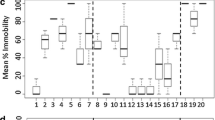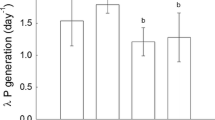Abstract
Organisms are exposed to multiple biotic and abiotic environmental stressors, which can influence the dynamics of individual populations and communities. Populations may also genetically adapt to both natural (e.g. disease) and anthropogenic (e.g. chemical pollution) stress. In the present study, we studied fitness consequences of exposure to both a parasite (i.e. biotic) and a pesticide (i.e. abiotic) for the water flea Daphnia. In addition, we investigated whether these fitness consequences change through time as a population evolves. Thus, we exposed Daphnia magna clones, hatched from dormant eggs isolated from different time layers of a natural dormant egg bank, to the parasite Pasteuria ramosa and the insecticide diazinon in a multifactorial experiment. While our experimental treatments for unknown reasons failed to induce disease symptoms in the Daphnia, we did observe a reduced survival of D. magna when simultaneously exposed to both the parasite and the pesticide. No increased mortality upon exposure to individual stressors was observed. We did not observe an evolutionary change in fitness response of the Daphnia clones hatched from different time horizons upon exposure to stressors.



Similar content being viewed by others
References
Aggarwal M, Naraharisetti SB, Dandapat S, Degen GH, Malik JK (2008) Perturbations in immune responses induced by concurrent subchronic exposure to arsenic and endosulfan. Toxicology 251:51–60
Allen DE, Little TJ (2011) Identifying energy constraints to parasite resistance. J Evol Biol 24:224–229
Ben-Ami F, Regoes RR, Ebert D (2008) A quantitative test of the relationship between parasite dose and infection probability across different host-parasite combinations. Proc R Soc B Biol Sci 275:853–859
Braune P, Rolff J (2001) Parasitism and survival in a damselfly: does host sex matter? Proc R Soc B Biol Sci 268:1133–1137
Bryner SF, Rigling D (2011) Temperature-dependent genotype-by-genotype interaction between a pathogenic fungus and its hyperparasitic virus. Am Nat 177:65–74
Cáceres CE (1998) Interspecific variation in the abundance, production, and emergence of Daphnia diapausing eggs. Ecology 79:1699–1710
Carvalho GR, Wolf HG (1989) Resting eggs of lake-Daphnia. I. Distribution, abundance and hatching of eggs collected from various depths in lake sediments. Freshw Biol 22:459–470
Chambers HW (1992) Organophosphorus compounds: an overview. In: Chambers JE, Levi PE (eds) Organophosphates. Chemistry, fate, and effects. Academic Press, San Diego
Chu FLE, Hale RC (1994) Relationship between pollution and susceptibility to infectious-disease in the Eastern Oyster, Crassostrea-Virginica. Mar Environ Res 38:243–256
Coors A, De Meester L (2008) Synergistic, antagonistic and additive effects of multiple stressors: predation threat, parasitism and pesticide exposure in Daphnia magna. J Appl Ecol 45:1820–1828
Coors A, De Meester L (2011) Fitness and virulence of a bacterial endoparasite in an environmentally stressed crustacean host. Parasitology 138:122–131
Coors A, Decaestecker E, Jansen M, De Meester L (2008) Pesticide exposure strongly enhances parasite virulence in an invertebrate host model. Oikos 117:1840–1846
Coors A, Vanoverbeke J, De Bie T, De Meester L (2009) Land use, genetic diversity and toxicant tolerance in natural populations of Daphnia magna. Aquat Toxicol 95:71–79
Cousyn C, De Meester L, Colbourne JK, Brendonck L, Verschuren D, Volckaert F (2001) Rapid local adaptation of zooplankton behavior to changes in predation pressure in absence of neutral genetic changes. Proc Natl Acad Sci USA 98:6256–6260
Daszak P, Cunningham AA, Hyatt AD (2000) Wildlife ecology—Emerging infectious diseases of wildlife—threats to biodiversity and human health. Science 287:443–449
De Meester L, Mergeay J, Michels H, Decaestecker E (2007) Reconstructing microevolutionary dynamics from layered egg banks. In: Alekseev V, De Stasio B, Gilbert J (eds) Diapause in aquatic invertebrates theory and human use. Springer, pp 159–166
Decaestecker E, Lefever C, De Meester L, Ebert D (2004) Haunted by the past: evidence for dormant stage banks of microparasites and epibionts of Daphnia. Limnol Oceanogr 49:1355–1364
Decaestecker E, Gaba S, Raeymaekers JAM, Stoks R, Van Kerckhoven L, Ebert D, De Meester L (2007) Host–parasite ‘Red Queen’ dynamics archived in pond sediment. Nature 450:870–873
Ebert D (2005) Ecology, epidemiology, and evolution of parasitism in Daphnia. National Library of Medicine (US), National Center for Biotechnology Information, Bethesda
Ebert D, Rainey P, Embley TM, Scholz D (1996) Development, life cycle, ultrastructure and phylogenetic position of Pasteuria ramosa metchnikoff 1888: rediscovery of an obligate endoparasite of Daphnia magna Straus. Philos Trans R Soc 351:1689–1701
Galloway T, Handy R (2003) Immunotoxicity of organophosphorous pesticides. Ecotoxicology 12:345–363
Gendron AD, Marcogliese DJ, Barbeau S, Christin MS, Brousseau P, Ruby S, Cyr D, Fournier M (2003) Exposure of leopard frogs to a pesticide mixture affects life history characteristics of the lungworm Rhabdias ranae. Oecologia 135:469–476
Hairston NG Jr, Lampert W, Caceres CE, Holtmeier CL, Weider LJ, Gaedke U, Fischer JM, Fox JA, Post DM (1999) Lake ecosystems: rapid evolution revealed by dormant eggs. Nature 401:446
Hairston NG, Holtmeier CL, Lampert W, Weider LJ, Post DM, Fischer JM, Caceres CE, Fox JA, Gaedke U (2001) Natural selection for grazer resistance to toxic cyanobacteria: evolution of phenotypic plasticity? Evolution 55:2203–2214
Holmstrup M, Bindesbol AM, Oostingh GJ, Duschl A, Scheil V, Kohler HR, Loureiro S, Soares A, Ferreira ALG, Kienle C, Gerhardt A, Laskowski R, Kramarz PE, Bayley M, Svendsen C, Spurgeon DJ (2010) Interactions between effects of environmental chemicals and natural stressors: a review. Sci Total Environ 408:3746–3762
Jansen M, Stoks R, Decaestecker E, Coors A, Van de Meutter F, De Meester L (2010) Local exposure shapes spatial patterns in infectivity and community structure of Daphnia parasites. J Anim Ecol 79:1023–1033
Jansen M, Stoks R, Coors A, van Doorslaer W, de Meester L (2011) Collateral damage: rapid exposure-induced evolution of pesticide resistance leads to increased susceptibility to parasites. Evolution 65:2681–2691
Jeppesen E, Leavitt P, De Meester L, Jensen JP (2001) Functional ecology and palaeolimnology: using cladoceran remains to reconstruct anthropogenic impact. Trends Ecol Evol 16:191–198
Jokela J, Taskinen J, Mutikainen P, Kopp K (2005) Virulence of parasites in hosts under environmental stress: experiments with anoxia and starvation. Oikos 108:156–164
Kawecki TJ, Ebert D (2004) Conceptual issues in local adaptation. Ecol Lett 7:1225–1241
Kerfoot WC, Weider LJ (2004) Experimental paleoecology (resurrection ecology): chasing Van Valen’s Red Queen hypothesis. Limnol Oceanogr 49:1300–1316
Kerfoot WC, Robbins JA, Weider LJ (1999) A new approach to historical reconstruction: combining descriptive and experimental paleolimnology. Limnol Oceanogr 44:1232–1247
King KC, McLaughlin JD, Boily M, Marcogliese DJ (2010) Effects of agricultural landscape and pesticides on parasitism in native bullfrogs. Biol Conserv 143:302–310
Klüttgen B, Dulmer U, Engels M, Ratte HT (1994) Adam, an artificial freshwater for the culture of zooplankton. Water Res 28:743–746
Konstantinou IK, Hela DG, Albanis TA (2006) The status of pesticide pollution in surface waters (rivers and lakes) of Greece. Part I. Review on occurrence and levels. Environ Pollut 141:555–570
Kretschmann A, Ashauer R, Preuss TG, Spaak P, Escher BI, Hollender J (2011) Toxicokinetic model describing bioconcentration and biotransformation of diazinon in Daphnia magna. Environ Sci Technol 45:4995–5002
Kreutz LC, Barcellos LJG, Marteninghe A, dos Santos ED, Zanatta R (2010) Exposure to sublethal concentration of glyphosate or atrazine-based herbicides alters the phagocytic function and increases the susceptibility of silver catfish fingerlings (Rhamdia quelen) to Aeromonas hydrophila challenge. Fish Shellfish Immunol 29:694–697
Krist AC, Jokela J, Wiehn J, Lively CM (2004) Effects of host condition on susceptibility to infection, parasite developmental rate, and parasite transmission in a snail-trematode interaction. J Evol Biol 17:33–40
Labbe P, Vale P, Little T (2010) Successfully resisting a pathogen is rarely costly in Daphnia magna. BMC Evol Biol 10:355
Lindström KM, Foufopoulos J, Pärn H, Wikelski M (2004) Immunological investments reflect parasite abundance in island populations of Darwin’s finches. Proc R Soc B Biol Sci 271:1513–1519
Little T, Killick SC (2007) Evidence for a cost of immunity when the crustacean Daphnia magna is exposed to the bacterial pathogen Pasteuria ramosa. Ecology 76:1202–1207
Marcogliese DJ, Pietrock M (2011) Combined effects of parasites and contaminants on animal health: parasites do matter. Trends Parasitol 27:123–130
Maxwell DM, Brecht KM, Koplovitz I, Sweeney RE (2006) Acetylcholinesterase inhibition: does it explain the toxicity of organophosphorus compounds? Arch Toxicol 80:756–760
McDowell JE, Lancaster BA, Leavitt DF, Rantamaki P, Ripley B (1999) The effects of lipophilic organic contaminants on reproductive physiology and disease processes in marine bivalve molluscs. Limnol Oceanogr 44:903–909
Metchnikoff E (1888) Pasteuria ramosa un representant des bacteries à division longitudinale. Ann I Pasteur Paris 4:165–170
Norris K, Evans MR (2000) Ecological immunology: life history trade-offs and immune defense in birds. Behav Ecol 11:19–26
Oostingh GJ, Wichmann G, Schmittner M, Lehmann I, Duschl A (2009) The cytotoxic effects of the organophosphates chlorpyrifos and diazinon differ from their immunomodulating effects. J Immunotoxicol 6:136–145
Pauwels K, De Meester L, Put S, Decaestecker E, Stoks R (2010) Rapid evolution of phenoloxidase expression, a component of innate immune function, in a natural population of Daphnia magna. Limnol Oceanogr 55:1408–1413
Relyea RA (2003) Predator cues and pesticides: a double dose of danger for amphibians. Ecol Appl 13:1515–1521
Rohr JR, Raffel TR, Sessions SK, Hudson PJ (2008) Understanding the net effects of pesticides on amphibian trematode infections. Ecol Appl 18:1743–1753
Sanchez M, Ferrando MD, Sancho E, Andreu-Molinar E (1998) Evaluation of a Daphnia magna renewal life-cycle test method with diazinon. J Environ Sci Health Part B Pestic Food Contam Agric Wastes 33:785–797
Schmid-Hempel P, Ebert D (2003) On the evolutionary ecology of specific immune defence. Trends Ecol Evol 18:27–32
Schoebel CN, Wolinska J, Spaak P (2010) Higher parasite resistance in Daphnia populations with recent epidemics. J Evol Biol 23:2370–2376
Sheldon BC, Verhulst S (1996) Ecological immunology: costly parasite defences and trade-offs in evolutionary ecology. Trends Ecol Evol 11:317–321
Sih A, Bell AM, Kerby JL (2004) Two stressors are far deadlier than one. Trends Ecol Evol 19:274–276
Singer H, Jaus S, Hanke I, Luck A, Hollender J, Alder AC (2010) Determination of biocides and pesticides by on-line solid phase extraction coupled with mass spectrometry and their behaviour in wastewater and surface water. Environ Pollut 158:3054–3064
Van Doorslaer W, Stoks R, Duvivier C, Bednarska A, De Meester L, Travisano M (2009) Population dynamics determine genetic adaptation to temperature in Daphnia. Evolution 63:1867–1878
Wittmer IK, Bader HP, Scheidegger R, Singer H, Luck A, Hanke I, Carlsson C, Stamm C (2010) Significance of urban and agricultural land use for biocide and pesticide dynamics in surface waters. Water Res 44:2850–2862
Yin M, Laforsch C, Lohr JN, Wolinska J (2011) Predator-induced defence makes Daphnia more vulnerable to parasites. Evolution 65:1482–1488
Acknowledgments
We thank Ellen Decaestecker for providing the hatchlings, several members of the Luc De Meester’s group for their help during the experiment and Andreas Kretschmann for hel** verifying the diazinon concentration. The manuscript improved by comments from Andreas Bruder, Christoph Tellenbach, Mat Seymour and two anonymous reviewers. This research was funded by the ETH Board (CCES-GEDIHAP), a Mobility Support from Eawag for CB and the KU Leuven Research Fund project PF/2010/07. MJ received a fellowship of the IWT, Flanders, while KP is a postdoctoral researcher with the FWO, Flanders.
Author information
Authors and Affiliations
Corresponding author
Additional information
Handling Editor: Thomas Mehner.
Rights and permissions
About this article
Cite this article
Buser, C.C., Jansen, M., Pauwels, K. et al. Combined exposure to parasite and pesticide causes increased mortality in the water flea Daphnia . Aquat Ecol 46, 261–268 (2012). https://doi.org/10.1007/s10452-012-9397-9
Received:
Accepted:
Published:
Issue Date:
DOI: https://doi.org/10.1007/s10452-012-9397-9




